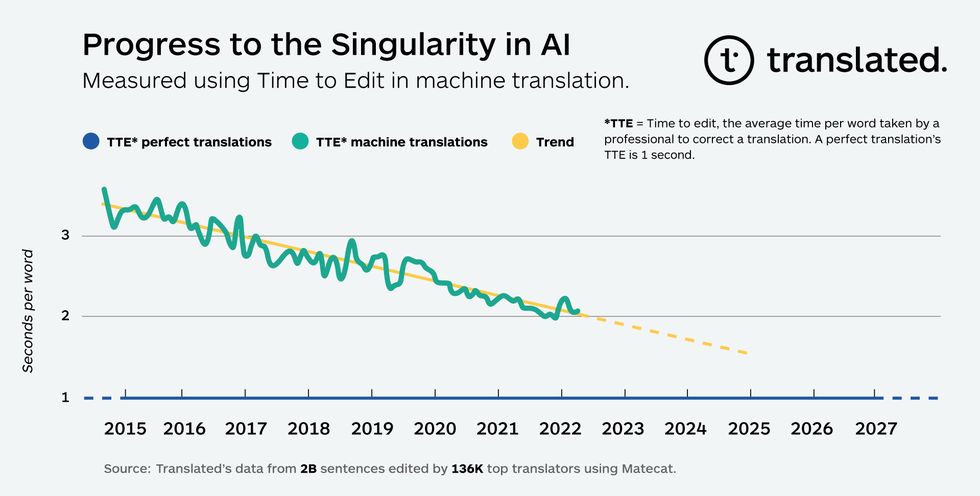- By one unique metric, we could approach technological singularity by the end of this decade, if not sooner.
- A translation company developed a metric, Time to Edit (TTE), to calculate the time it takes for professional human editors to fix AI-generated translations compared to human ones. This may help quantify the speed toward singularity.
- An AI that can translate speech as well as a human could change society.
In the world of artificial intelligence, the idea of “singularity” looms large. This slippery concept describes the moment AI exceeds beyond human control and rapidly transforms society. The tricky thing about AI singularity (and why it borrows terminology from black hole physics) is that it’s enormously difficult to predict where it begins and nearly impossible to know what’s beyond this technological “event horizon.”
However, some AI researchers are on the hunt for signs of reaching singularity measured by AI progress approaching the skills and ability comparable to a human. One such metric, defined by Translated, a Rome-based translation company, is an AI’s ability to translate speech at the accuracy of a human. Language is one of the most difficult AI challenges, but a computer that could close that gap could theoretically show signs of Artificial General Intelligence (AGI).
“That’s because language is the most natural thing for humans,” Translated CEO Marco Trombetti said at a conference in Orlando, Florida, in December. “Nonetheless, the data Translated collected clearly shows that machines are not that far from closing the gap.”
The company tracked its AI’s performance from 2014 to 2022 using a metric called “Time to Edit,” or TTE, which calculates the time it takes for professional human editors to fix AI-generated translations compared to human ones. Over that 8-year period and analyzing over 2 billion post-edits, Translated’s AI showed a slow, but undeniable improvement as it slowly closed the gap toward human-level translation quality.
On average, it takes a human translator roughly one second to edit each word of another human translator, according to Translated. In 2015, it took professional editors approximately 3.5 seconds per word to check a machine-translated (MT) suggestion — today that number is just 2 seconds. If the trend continues, Translated’s AI will be as good as human-produced translation by the end of the decade (or even sooner).
“The change is so small that every single day you don’t perceive it, but when you see progress … across 10 years, that is impressive,” Trombetti said on a podcast in December. “This is the first time ever that someone in the field of artificial intelligence did a prediction of the speed to singularity.”
Although this is a novel approach to quantifying how close humanity is to approaching singularity, this definition of singularity runs into similar problems of identifying AGI more broadly. Although perfecting human speech is certainly a frontier in AI research, the impressive skill doesn’t necessarily make a machine intelligent (not to mention how many researchers don’t even agree on what “intelligence” is).
Whether these hyper-accurate translators are harbingers of our technological doom or not, that doesn’t lessen Translated’s AI accomplishment. An AI capable of translating speech as well as a human could very well change society, even if the true “technological singularity” remains ever elusive.
News
New Once-a-Week Shot Promises Life-Changing Relief for Parkinson’s Patients
A once-a-week shot from Australian scientists could spare people with Parkinson’s the grind of taking pills several times a day. The tiny, biodegradable gel sits under the skin and releases steady doses of two [...]
Weekly injectable drug offers hope for Parkinson’s patients
A new weekly injectable drug could transform the lives of more than eight million people living with Parkinson's disease, potentially replacing the need for multiple daily tablets. Scientists from the University of South Australia [...]
Most Plastic in the Ocean Is Invisible—And Deadly
Nanoplastics—particles smaller than a human hair—can pass through cell walls and enter the food web. New research suggest 27 million metric tons of nanoplastics are spread across just the top layer of the North [...]
Repurposed drugs could calm the immune system’s response to nanomedicine
An international study led by researchers at the University of Colorado Anschutz Medical Campus has identified a promising strategy to enhance the safety of nanomedicines, advanced therapies often used in cancer and vaccine treatments, [...]
Nano-Enhanced Hydrogel Strategies for Cartilage Repair
A recent article in Engineering describes the development of a protein-based nanocomposite hydrogel designed to deliver two therapeutic agents—dexamethasone (Dex) and kartogenin (KGN)—to support cartilage repair. The hydrogel is engineered to modulate immune responses and promote [...]
New Cancer Drug Blocks Tumors Without Debilitating Side Effects
A new drug targets RAS-PI3Kα pathways without harmful side effects. It was developed using high-performance computing and AI. A new cancer drug candidate, developed through a collaboration between Lawrence Livermore National Laboratory (LLNL), BridgeBio Oncology [...]
Scientists Are Pretty Close to Replicating the First Thing That Ever Lived
For 400 million years, a leading hypothesis claims, Earth was an “RNA World,” meaning that life must’ve first replicated from RNA before the arrival of proteins and DNA. Unfortunately, scientists have failed to find [...]
Why ‘Peniaphobia’ Is Exploding Among Young People (And Why We Should Be Concerned)
An insidious illness is taking hold among a growing proportion of young people. Little known to the general public, peniaphobia—the fear of becoming poor—is gaining ground among teens and young adults. Discover the causes [...]
Team finds flawed data in recent study relevant to coronavirus antiviral development
The COVID pandemic illustrated how urgently we need antiviral medications capable of treating coronavirus infections. To aid this effort, researchers quickly homed in on part of SARS-CoV-2's molecular structure known as the NiRAN domain—an [...]
Drug-Coated Neural Implants Reduce Immune Rejection
Summary: A new study shows that coating neural prosthetic implants with the anti-inflammatory drug dexamethasone helps reduce the body’s immune response and scar tissue formation. This strategy enhances the long-term performance and stability of electrodes [...]
Scientists discover cancer-fighting bacteria that ‘soak up’ forever chemicals in the body
A family of healthy bacteria may help 'soak up' toxic forever chemicals in the body, warding off their cancerous effects. Forever chemicals, also known as PFAS (per- and polyfluoroalkyl substances), are toxic chemicals that [...]
Johns Hopkins Researchers Uncover a New Way To Kill Cancer Cells
A new study reveals that blocking ribosomal RNA production rewires cancer cell behavior and could help treat genetically unstable tumors. Researchers at the Johns Hopkins Kimmel Cancer Center and the Department of Radiation Oncology and Molecular [...]
AI matches doctors in mapping lung tumors for radiation therapy
In radiation therapy, precision can save lives. Oncologists must carefully map the size and location of a tumor before delivering high-dose radiation to destroy cancer cells while sparing healthy tissue. But this process, called [...]
Scientists Finally “See” Key Protein That Controls Inflammation
Researchers used advanced microscopy to uncover important protein structures. For the first time, two important protein structures in the human body are being visualized, thanks in part to cutting-edge technology at the University of [...]
AI tool detects 9 types of dementia from a single brain scan
Mayo Clinic researchers have developed a new artificial intelligence (AI) tool that helps clinicians identify brain activity patterns linked to nine types of dementia, including Alzheimer's disease, using a single, widely available scan—a transformative [...]
Is plastic packaging putting more than just food on your plate?
New research reveals that common food packaging and utensils can shed microscopic plastics into our food, prompting urgent calls for stricter testing and updated regulations to protect public health. Beyond microplastics: The analysis intentionally [...]






















